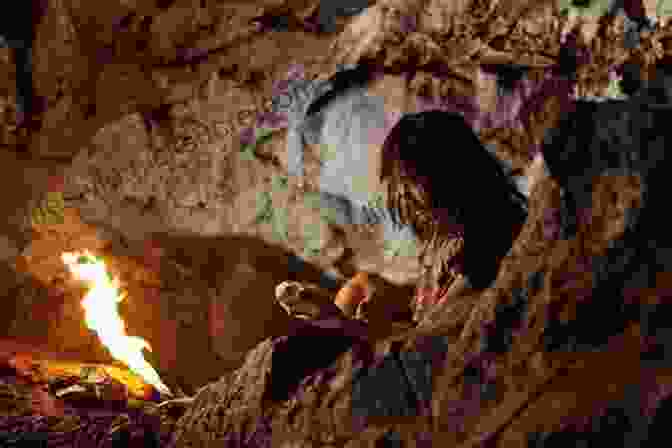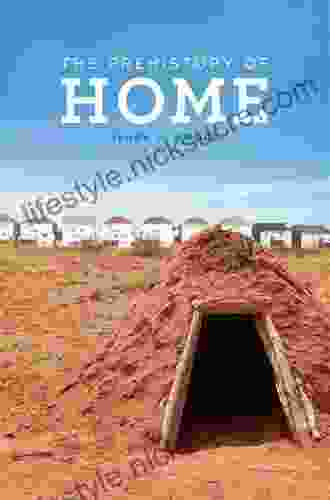The Prehistory of Home: Exploring the Origins and Evolution of Human Habitation


5 out of 5
| Language | : | English |
| File size | : | 3290 KB |
| Text-to-Speech | : | Enabled |
| Screen Reader | : | Supported |
| Enhanced typesetting | : | Enabled |
| Word Wise | : | Enabled |
| Print length | : | 284 pages |
| Lending | : | Enabled |
: The Dawn of Human Habitation
Since time immemorial, the concept of home has been deeply ingrained in human consciousness. It represents a place of comfort, security, and belonging—a sanctuary that nurtures our physical and emotional well-being. The prehistory of home, however, is a complex and multi-faceted narrative, one that spans millennia and unveils the remarkable ingenuity and adaptability of our ancestors. This article will delve into the fascinating origins and evolution of human habitation, tracing its journey from humble cave shelters to the grandiose structures that characterize modern cities.
Chapter 1: The Earliest Shelters: Caves and Rock Formations
The earliest known evidence of human habitation dates back to the Paleolithic era, when our ancestors sought refuge in naturally occurring shelters such as caves. These caves provided protection from the elements, predators, and potential threats, fostering a sense of security and belonging. As humans began to explore their surroundings, they also utilized rock formations and overhangs, which offered similar advantages. These early shelters were often modified and adapted to suit human needs, such as the creation of sleeping areas, storage spaces, and possibly even rudimentary hearths.
Chapter 2: The Neolithic Revolution and the Rise of Settlements
With the onset of the Neolithic era, around 10,000 years ago, human society underwent a transformative shift marked by the advent of agriculture. This agricultural revolution led to the emergence of settled communities, as people began to cultivate crops and domesticate animals for sustenance. Neolithic settlements typically consisted of small, clustered dwellings made from wood, stone, or other locally available materials. These settlements often featured communal areas, storage facilities, and evidence of organized social structures.
Chapter 3: The Birth of Architecture: Mesopotamia and Ancient Egypt
The development of complex societies in Mesopotamia and Ancient Egypt gave rise to the emergence of monumental architecture. The iconic Ziggurats of Sumer, some of the earliest examples of large-scale construction, served as religious and administrative centers. In Egypt, the construction of pyramids showcased the technological prowess and architectural ingenuity of the ancient Egyptians. These colossal structures, designed as tombs for pharaohs, are a testament to the advanced planning, engineering, and labor organization of the time.
Chapter 4: The Classical Civilizations: Greece and Rome
The classical civilizations of Greece and Rome made significant contributions to the evolution of home design. Greek architecture emphasized harmony, proportion, and beauty, exemplified by iconic structures such as the Parthenon. Roman architecture, on the other hand, was characterized by its practicality and engineering prowess, with structures such as the Roman Colosseum showcasing innovative construction techniques and the use of concrete. Roman villas, with their elaborate courtyards, gardens, and luxurious amenities, provided a glimpse into the lavish lifestyles of the wealthy elite.
Chapter 5: The Middle Ages: Castles, Cathedrals, and Urban Centers
The Middle Ages witnessed a period of architectural diversity and innovation. Castles, constructed by feudal lords for protection and defense, emerged as symbols of power and authority. With the rise of Christianity, majestic cathedrals were built as centers of worship and community life. Urban centers flourished, characterized by dense housing, narrow streets, and bustling marketplaces. Medieval homes, typically built of wood or stone, ranged from modest cottages to grand palaces, reflecting the social hierarchies of the time.
Chapter 6: The Renaissance and Enlightenment: Rebirth and Scientific Advancement
The Renaissance and Enlightenment brought about a renewed interest in classical architecture and a focus on humanism. Palaces and mansions were designed with elaborate facades, symmetrical layouts, and opulent interiors. Scientific advancements led to improvements in construction techniques and the use of new materials. Urban planning became a priority, with cities being redesigned to maximize efficiency and aesthetics.
Chapter 7: The Industrial Revolution and the Rise of Modern Housing
The Industrial Revolution ushered in a period of rapid urbanization and technological advancements. Mass production and new construction methods made housing more accessible to the masses. Tenements and row houses became common features of urban landscapes. The concept of public housing emerged to address the housing needs of the growing urban population.
Chapter 8: The 20th Century: Modernism, Suburbs, and Smart Homes
The 20th century witnessed the rise of modernist architecture, characterized by its emphasis on functionality, simplicity, and the use of new materials such as concrete and steel. Suburban development flourished, with the rise of single-family homes and the proliferation of automobiles. Advancements in technology led to the development of smart homes, equipped with automated systems and energy-efficient features.
: The Future of Home
As we look to the future, the concept of home continues to evolve. With the rise of sustainable architecture, eco-friendly materials, and innovative construction techniques, the homes of tomorrow promise to be more environmentally conscious and technologically advanced. The future of home may also lie in modular designs, smaller living spaces, and shared housing arrangements, reflecting the changing demographics and lifestyles of modern society. One thing is for certain: the pursuit of creating comfortable, secure, and meaningful homes will continue to be an integral part of the human experience.
5 out of 5
| Language | : | English |
| File size | : | 3290 KB |
| Text-to-Speech | : | Enabled |
| Screen Reader | : | Supported |
| Enhanced typesetting | : | Enabled |
| Word Wise | : | Enabled |
| Print length | : | 284 pages |
| Lending | : | Enabled |
Do you want to contribute by writing guest posts on this blog?
Please contact us and send us a resume of previous articles that you have written.
 Fiction
Fiction Non Fiction
Non Fiction Romance
Romance Mystery
Mystery Thriller
Thriller SciFi
SciFi Fantasy
Fantasy Horror
Horror Biography
Biography Selfhelp
Selfhelp Business
Business History
History Classics
Classics Poetry
Poetry Childrens
Childrens Young Adult
Young Adult Educational
Educational Cooking
Cooking Travel
Travel Lifestyle
Lifestyle Spirituality
Spirituality Health
Health Fitness
Fitness Technology
Technology Science
Science Arts
Arts Crafts
Crafts DIY
DIY Gardening
Gardening Petcare
Petcare Steven Charleston
Steven Charleston Michael Ondaatje
Michael Ondaatje Eric Zweig
Eric Zweig Cynthia Gabriel
Cynthia Gabriel June Cl Tan
June Cl Tan Craig Larman
Craig Larman Mark Stallard
Mark Stallard Jeffrey Steadman
Jeffrey Steadman Dr Scott A Johnson
Dr Scott A Johnson Jessica Hatcher Moore
Jessica Hatcher Moore Victoria Wood
Victoria Wood Ellie Wood
Ellie Wood Diane Greer
Diane Greer Stephenie Meyer
Stephenie Meyer Mariano Anaya
Mariano Anaya Brian Klaas
Brian Klaas Joe Dante
Joe Dante Jonathan Bartlett
Jonathan Bartlett Jean Christie Ashmore
Jean Christie Ashmore Karen Deerwester
Karen Deerwester C L Simchick
C L Simchick Brian Pace
Brian Pace David Salsburg
David Salsburg Christina Kamp
Christina Kamp Dmv Test Bank
Dmv Test Bank Amir Alexander
Amir Alexander Glenn Stout
Glenn Stout Donovan Hohn
Donovan Hohn Susan White
Susan White Sean Go
Sean Go Paul Oliver
Paul Oliver Amber Foster
Amber Foster Erica T Lehrer
Erica T Lehrer Chris Carlsson
Chris Carlsson Victoria Richards
Victoria Richards Ruth M Tappen
Ruth M Tappen Frank Nappi
Frank Nappi Amy Bizzarri
Amy Bizzarri William G Dever
William G Dever Benjamin Jelen
Benjamin Jelen David Guymer
David Guymer Tracy Lorraine
Tracy Lorraine Don Mann
Don Mann Amara Charles
Amara Charles Catherine Ryan Gregory
Catherine Ryan Gregory Silvia Botros
Silvia Botros Toni Tone
Toni Tone Paul Dickson
Paul Dickson Michael Winkelman
Michael Winkelman Arlene Blum
Arlene Blum Amrita Pande
Amrita Pande Ashley Scott
Ashley Scott Ray Mancini
Ray Mancini David Grinspoon
David Grinspoon Jason Borte
Jason Borte Stephen Walker
Stephen Walker James W Williams
James W Williams Stanley I Greenspan
Stanley I Greenspan Paul Kaplowitz
Paul Kaplowitz Shanna Cunning
Shanna Cunning Ned Seaton
Ned Seaton Nikala Smith
Nikala Smith Malba Tahan
Malba Tahan Autumn Jordon
Autumn Jordon Anna B Doe
Anna B Doe Erika Napoletano
Erika Napoletano Saleh Alkhalifa
Saleh Alkhalifa Nisha Garg
Nisha Garg Charles Thompson
Charles Thompson David Elkington
David Elkington Richard Wagamese
Richard Wagamese Dan Abnett
Dan Abnett Robert A Weinberg
Robert A Weinberg Anthony Haynes
Anthony Haynes Sian Warriner
Sian Warriner Elise Christie
Elise Christie Brittany Clair
Brittany Clair Derek Thompson
Derek Thompson Bethanne Kim
Bethanne Kim Mark Turley
Mark Turley Vince Kotchian
Vince Kotchian Jim Santos
Jim Santos Amiee Mueller
Amiee Mueller Kate Parham Kordsmeier
Kate Parham Kordsmeier Vicki Hearne
Vicki Hearne Henry A Zumbrun 2
Henry A Zumbrun 2 Elizabeth S Gilbert
Elizabeth S Gilbert Amber O Neal Johnston
Amber O Neal Johnston Nicholeen Peck
Nicholeen Peck Chad Ford
Chad Ford Tom Colicchio
Tom Colicchio Sean Gibson
Sean Gibson Warren B Powell
Warren B Powell Temple Grandin
Temple Grandin Amante P Marinas
Amante P Marinas Desi Northup
Desi Northup Don Stradley
Don Stradley Rick Deutsch
Rick Deutsch Sterling Test Prep
Sterling Test Prep Eric T Knight
Eric T Knight Traci Gormley
Traci Gormley Lady Antiva
Lady Antiva Mac Fortner
Mac Fortner Denise Ni
Denise Ni Kumo Kagyu
Kumo Kagyu Cole Hersowitz
Cole Hersowitz Cookie O Gorman
Cookie O Gorman Don Orwell
Don Orwell Emma Mae Jenkins
Emma Mae Jenkins Jack Ewing
Jack Ewing Clancy Cavnar
Clancy Cavnar Jean Rose
Jean Rose Alex Stone
Alex Stone Cordelia K Castel
Cordelia K Castel Janet Engle
Janet Engle Charles J Alsheimer
Charles J Alsheimer Stephen J Collier
Stephen J Collier Andy Couturier
Andy Couturier Maria Youtman
Maria Youtman Buck Tilton
Buck Tilton Hadley Wickham
Hadley Wickham Leslie Sansone
Leslie Sansone Sarah Dessen
Sarah Dessen Amy Camp
Amy Camp Valerie Bass
Valerie Bass Michaela Riva Gaaserud
Michaela Riva Gaaserud Carlo Buzzichelli
Carlo Buzzichelli David Burch
David Burch Amy Brown
Amy Brown Md Rezowan Ahmed
Md Rezowan Ahmed Swede Burns
Swede Burns American Math Academy
American Math Academy Peter Larson
Peter Larson Shaun Gallagher
Shaun Gallagher Sarah Morgan Haydock
Sarah Morgan Haydock Topher Donahue
Topher Donahue Sandra T Barnes
Sandra T Barnes Amber Zygutis
Amber Zygutis Patricia L Papernow
Patricia L Papernow Michael R Poll
Michael R Poll Ananda Lowe
Ananda Lowe Amy Mccready
Amy Mccready Dr Bob Rotella
Dr Bob Rotella H Bedford Jones
H Bedford Jones Elizabeth Lim
Elizabeth Lim Umer W
Umer W Joe Dan Lowry
Joe Dan Lowry Jerry D Moore
Jerry D Moore Doug Peterson
Doug Peterson Michelle Newhart
Michelle Newhart Joseph Howse
Joseph Howse Melody Schreiber
Melody Schreiber Joan Freeman
Joan Freeman Michael Parker Pearson
Michael Parker Pearson Stephen M Barr
Stephen M Barr Randall E Schumacker
Randall E Schumacker Jack Freeman
Jack Freeman Amy B Middleman
Amy B Middleman Angela Moore
Angela Moore Cheri Rae
Cheri Rae Torey L Hayden
Torey L Hayden Roman Gelperin
Roman Gelperin Amie Lands
Amie Lands Bruce Dowbiggin
Bruce Dowbiggin Kresley Cole
Kresley Cole Jake Maddox
Jake Maddox Amit Saha
Amit Saha Helena P Blavasky
Helena P Blavasky Charles Hall
Charles Hall Gina Chen
Gina Chen Jeff Gaudette
Jeff Gaudette Paul Wieland
Paul Wieland Dima Zales
Dima Zales Alex Polyakov
Alex Polyakov Stanley J Farlow
Stanley J Farlow David Yoon
David Yoon Alan I Marcus
Alan I Marcus Gal Dem
Gal Dem Reinhold Messner
Reinhold Messner Julie Schacht Sway
Julie Schacht Sway Amelia Parker
Amelia Parker Mitt Romney
Mitt Romney Sarah Woodbury
Sarah Woodbury Joseph Klaits
Joseph Klaits Rose Mannering
Rose Mannering Meikang Qiu
Meikang Qiu Guillaume Haeringer
Guillaume Haeringer Wolf Moon
Wolf Moon Jd Mader
Jd Mader John Bingham
John Bingham Ronda Rousey
Ronda Rousey Kate Tietje
Kate Tietje Tim Hornbaker
Tim Hornbaker Shannon O Bourne
Shannon O Bourne Dolores Kong
Dolores Kong John Ferrell
John Ferrell Joe E Harvey
Joe E Harvey P Aarne Vesilind
P Aarne Vesilind Devin Olsen
Devin Olsen Amy Bleuel
Amy Bleuel Amie Kaufman
Amie Kaufman Christopher E Larsen
Christopher E Larsen Amelia Edith Huddleston Barr
Amelia Edith Huddleston Barr Christopher Harlan
Christopher Harlan Nina Freudenberger
Nina Freudenberger Ana And Jack Hicks
Ana And Jack Hicks Mark Taylor
Mark Taylor Jason Thompson
Jason Thompson Jonathan Law
Jonathan Law Louise Bates Ames
Louise Bates Ames Norman Doidge
Norman Doidge Sandra Bardwell
Sandra Bardwell Anthony Horowitz
Anthony Horowitz Sonia Hartl
Sonia Hartl Stephen Barr
Stephen Barr Oscar Baechler
Oscar Baechler Matthew L Martin
Matthew L Martin Amy Blakeslee
Amy Blakeslee Ruth Nestvold
Ruth Nestvold Amby Cooper
Amby Cooper Rob Antoun
Rob Antoun Michael Reichert
Michael Reichert Pinky Mckay
Pinky Mckay James Mullaney
James Mullaney Laurie A Watkins
Laurie A Watkins Robert W D Ball
Robert W D Ball Marina Robb
Marina Robb Sheri Van Dijk
Sheri Van Dijk Wendy Margolis
Wendy Margolis Howard J Meditz
Howard J Meditz Courtney Defeo
Courtney Defeo Tahlia Kirk
Tahlia Kirk Harley Reid
Harley Reid Rob Fisher
Rob Fisher Joel Cotton
Joel Cotton Jessica Cunsolo
Jessica Cunsolo Rosalind Wiseman
Rosalind Wiseman Bridget Ericsson
Bridget Ericsson Joseph Mcmoneagle
Joseph Mcmoneagle Pav Bryan
Pav Bryan Stephen Goodwin
Stephen Goodwin Eric E Bowne
Eric E Bowne Kathy Spratt
Kathy Spratt Michael Cosgrove
Michael Cosgrove Amber Lee Sellers
Amber Lee Sellers Derrick Jensen
Derrick Jensen Vivian Vande Velde
Vivian Vande Velde Redmond O Hanlon
Redmond O Hanlon Julie Barlow
Julie Barlow Tom Patri
Tom Patri Md Mahady Hasan
Md Mahady Hasan William Bohan
William Bohan Kenneth P Stephens
Kenneth P Stephens Andy Hunt
Andy Hunt Ken Chaddock
Ken Chaddock Jameson M Wetmore
Jameson M Wetmore Jenni Hicks
Jenni Hicks The 60 Minutes Summary
The 60 Minutes Summary Nikhil Bhardwaj
Nikhil Bhardwaj Jacob Bronowski
Jacob Bronowski Pico Iyer
Pico Iyer Mike Adamick
Mike Adamick Eugene C Toy
Eugene C Toy Jan Marie Mueller
Jan Marie Mueller Douglas Wilson
Douglas Wilson James P Kelly
James P Kelly William Glasser M D
William Glasser M D Jeanne Ryan
Jeanne Ryan Christine Fanthome
Christine Fanthome Deborah Lipsky
Deborah Lipsky Krystal Sutherland
Krystal Sutherland Jenny Landreth
Jenny Landreth Rich Rousseau
Rich Rousseau Jan E Stets
Jan E Stets Jon Bonnell
Jon Bonnell Erik Qualman
Erik Qualman Susanna Heli
Susanna Heli Amy Perry
Amy Perry L Frank Baum
L Frank Baum Tanya Turner
Tanya Turner Sarah Sumbal
Sarah Sumbal Patrick O Sullivan
Patrick O Sullivan Kezia Endsley
Kezia Endsley Sarah J Maas
Sarah J Maas Robb Walsh
Robb Walsh Neville Goddard
Neville Goddard Nick Kolenda
Nick Kolenda Erin Chack
Erin Chack Muhammad Vandestra
Muhammad Vandestra Steven C Hayes
Steven C Hayes Claudia J Carr
Claudia J Carr Andrey Ryanskiy
Andrey Ryanskiy A Sorority Of Mothers
A Sorority Of Mothers American Psychological Association
American Psychological Association Sandra Luna Mccune
Sandra Luna Mccune Paul Graham
Paul Graham Cody Monk
Cody Monk Wade Rouse
Wade Rouse John Jacobs
John Jacobs Kate Fox
Kate Fox Liz Fosslien
Liz Fosslien Jennifer S Kelly
Jennifer S Kelly Tim Marshall
Tim Marshall Christopher Cousteau
Christopher Cousteau Amelia Freer
Amelia Freer Gary Wiener
Gary Wiener Gerald Corey
Gerald Corey American Baseball Coaches Association
American Baseball Coaches Association Cathy Williams
Cathy Williams Amira Mikhail
Amira Mikhail John L Field
John L Field C W Lockhart
C W Lockhart Amy Baldwin
Amy Baldwin Zeshan Qureshi
Zeshan Qureshi Trent Shelton
Trent Shelton George Bernard Shaw
George Bernard Shaw Edward J Denecke
Edward J Denecke Julie Caplin
Julie Caplin Test Masters
Test Masters Candy Verney
Candy Verney John Mcpherson
John Mcpherson Timothy Malcolm
Timothy Malcolm Mark W T Harvey
Mark W T Harvey Lisa Zimmer Hatch
Lisa Zimmer Hatch Joseph P Weir
Joseph P Weir Kasie West
Kasie West Donna Williams
Donna Williams Theresa I Soto
Theresa I Soto Shere Hite
Shere Hite Dave Hanson
Dave Hanson Tavi Gevinson
Tavi Gevinson Adam Cort
Adam Cort Rosanna Davison
Rosanna Davison Holly Herrick
Holly Herrick Summer Michaud Skog
Summer Michaud Skog Naomi Oreskes
Naomi Oreskes Paul Schwartz
Paul Schwartz Ignatius Donnelly
Ignatius Donnelly Sharon K Zumbrunn
Sharon K Zumbrunn Pamela Lynn
Pamela Lynn E T Bryant
E T Bryant Iain Pardoe
Iain Pardoe Spike Dykes
Spike Dykes Peter Hayes
Peter Hayes Jeff Martone
Jeff Martone Sue Monk Kidd
Sue Monk Kidd Lisa Maloney
Lisa Maloney Clotaire Rapaille
Clotaire Rapaille Byron Nelson
Byron Nelson Catherine Dees
Catherine Dees Candida Lawrence
Candida Lawrence Theresa Y Wee M D
Theresa Y Wee M D Heather Macfadyen
Heather Macfadyen J Marin Younker
J Marin Younker Larry K Brendtro
Larry K Brendtro Marco Ferrero
Marco Ferrero Steve Greenberg
Steve Greenberg Julie Mosier
Julie Mosier Bill Carter
Bill Carter John Lukacs
John Lukacs Philippa Langley
Philippa Langley Nicholas A Christakis
Nicholas A Christakis Terry Wieland
Terry Wieland Antonio R Damasio
Antonio R Damasio Philip Gibson
Philip Gibson Danny Dreyer
Danny Dreyer Tyler Simmons
Tyler Simmons Dana Obleman
Dana Obleman David Ranney
David Ranney Josh Taylor
Josh Taylor Dr Elizabeth Cherevaty Nd Rac
Dr Elizabeth Cherevaty Nd Rac Randy Schultz
Randy Schultz Heidi J Larson
Heidi J Larson Garrett M Fitzmaurice
Garrett M Fitzmaurice Marit Weisenberg
Marit Weisenberg Alan Margot
Alan Margot Isabella Krystynek
Isabella Krystynek James E Packer
James E Packer Matthew Lombardi
Matthew Lombardi Laekan Zea Kemp
Laekan Zea Kemp Deborah J Rumsey
Deborah J Rumsey Victor J Stenger
Victor J Stenger Kevin Stiegelmaier
Kevin Stiegelmaier Jack Falla
Jack Falla Chris Irons
Chris Irons John A Buehrens
John A Buehrens Dom Amore
Dom Amore Art Star
Art Star Django Paris
Django Paris Jayson Gaddis
Jayson Gaddis Kathleen Glasgow
Kathleen Glasgow Rick Stanton
Rick Stanton Tom Deck
Tom Deck Tom Taulli
Tom Taulli Martin Williams
Martin Williams Anne Chambers
Anne Chambers Peter Worley
Peter Worley K M Shea
K M Shea Kristine Kathryn Rusch
Kristine Kathryn Rusch Dan Schlossberg
Dan Schlossberg Kris Leonard
Kris Leonard Camille Glenn
Camille Glenn Alexandrea Weis
Alexandrea Weis Tabitha Suzuma
Tabitha Suzuma Jocelyn Goodwin
Jocelyn Goodwin Josiah Hesse
Josiah Hesse Jeremy J Baumberg
Jeremy J Baumberg Vinod Kumar Khanna
Vinod Kumar Khanna Shalabh Aggarwal
Shalabh Aggarwal Trevor Day
Trevor Day Tamora Pierce
Tamora PierceK D
 Deborah Vinall Psyd Lmft
Deborah Vinall Psyd Lmft Ruta Nonacs
Ruta Nonacs Amber Smith
Amber Smith William Stillman
William Stillman Josephine Atluri
Josephine Atluri Jack Nisbet
Jack Nisbet Mark Worden
Mark Worden Robyn Davidson
Robyn Davidson Grant Dever
Grant Dever Chloe Gong
Chloe Gong Eugenia Viti
Eugenia Viti Jonathon Miller Weisberger
Jonathon Miller Weisberger William Rosen
William Rosen Jennifer Margulis
Jennifer Margulis Rodney M Howard Browne
Rodney M Howard Browne Amber Lia
Amber Lia J Stephen Jones
J Stephen Jones Jack Weatherford
Jack Weatherford Rachel Gurevich
Rachel Gurevich Ned Vizzini
Ned Vizzini Suzanne Stabile
Suzanne Stabile Laini Taylor
Laini Taylor Joellen Patterson
Joellen Patterson Paul Kockelman
Paul Kockelman Lizabeth Hardman
Lizabeth Hardman Eric Tyndall
Eric Tyndall Frederick Lenz
Frederick Lenz Johan Norberg
Johan Norberg Martin Pollizotto
Martin Pollizotto Chad Starkey
Chad Starkey Jean Van T Hul
Jean Van T Hul Tijan
Tijan Brendan Leonard
Brendan Leonard Amy Adele Hasinoff
Amy Adele Hasinoff Laura Slinn
Laura Slinn K F Breene
K F Breene Brian Kateman
Brian Kateman Therese A Rando
Therese A Rando Lars Andersen
Lars Andersen John Maxwell Wood
John Maxwell Wood Ryan Gray
Ryan Gray J L Weil
J L Weil Joseph Conrad
Joseph Conrad Richard Cohen
Richard Cohen Sheena Johnstone
Sheena Johnstone Don Bowers
Don Bowers Gail Maccoll
Gail Maccoll Thom Hartmann
Thom Hartmann Michael Abayomi
Michael Abayomi Robert Melillo
Robert Melillo Andy Singleton
Andy Singleton Jack Tupp
Jack Tupp Kieron Gillen
Kieron Gillen Katherine Kurtz
Katherine Kurtz Nathan Belofsky
Nathan Belofsky Fred Pyrczak
Fred Pyrczak Gia Giasullo
Gia Giasullo Marshall Goldsmith
Marshall Goldsmith Theodore Sider
Theodore Sider Joseph Wayne Smith
Joseph Wayne Smith Kyle Hunt
Kyle Hunt Helen E Fisher
Helen E Fisher Kathy A Zahler
Kathy A Zahler Marisa Anne Bass
Marisa Anne Bass Thomas J Whalen
Thomas J Whalen Joe Nickell
Joe Nickell Kathleen M Stacy
Kathleen M Stacy
Light bulbAdvertise smarter! Our strategic ad space ensures maximum exposure. Reserve your spot today!

 Justin BellKettlebell Rx: The Definitive Guide to Jeff Martone's Transformative Fitness...
Justin BellKettlebell Rx: The Definitive Guide to Jeff Martone's Transformative Fitness...
 Johnny TurnerSports Nutrition For Endurance Athletes 3rd Ed.: A Comprehensive Guide to...
Johnny TurnerSports Nutrition For Endurance Athletes 3rd Ed.: A Comprehensive Guide to...
 Banana YoshimotoUnveiling the Extraordinary Life and Legacy of "How Played the Game: An...
Banana YoshimotoUnveiling the Extraordinary Life and Legacy of "How Played the Game: An... Luke BlairFollow ·19.2k
Luke BlairFollow ·19.2k Travis FosterFollow ·10.1k
Travis FosterFollow ·10.1k Harry HayesFollow ·17.9k
Harry HayesFollow ·17.9k Jesus MitchellFollow ·17.1k
Jesus MitchellFollow ·17.1k Donovan CarterFollow ·19.7k
Donovan CarterFollow ·19.7k Ed CooperFollow ·12.7k
Ed CooperFollow ·12.7k Everett BellFollow ·4.9k
Everett BellFollow ·4.9k George OrwellFollow ·5.8k
George OrwellFollow ·5.8k

 Ira Cox
Ira CoxUnveiling the Hidden Gem: Moon, Virginia - A Washington...
Nestled within the picturesque...

 Jorge Luis Borges
Jorge Luis BorgesThe Ultimate Survivalist's Medical Guide: A Comprehensive...
In the realm of...

 Henry Green
Henry GreenDavid Douglas: Exploring the Natural History of the...
David Douglas was a...

 Eric Hayes
Eric HayesUnderstanding Citizenship in a Globalized World: A...
Citizenship is a complex and multifaceted...

 Will Ward
Will WardUnveiling Research Real Talk: Navigating the Labyrinth of...
Research, the...
5 out of 5
| Language | : | English |
| File size | : | 3290 KB |
| Text-to-Speech | : | Enabled |
| Screen Reader | : | Supported |
| Enhanced typesetting | : | Enabled |
| Word Wise | : | Enabled |
| Print length | : | 284 pages |
| Lending | : | Enabled |








